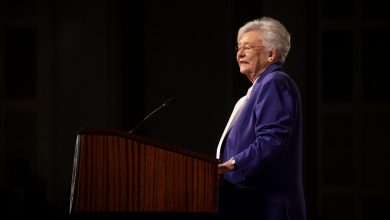At 100, the ‘Just William’ Books Are an Icon of British Childhood

Where to begin with William Brown? The stubbornly disheveled, snub-nosed 11-year-old protagonist of the writer Richmal Crompton’s wildly popular “Just William” stories, 100 this year, is an astutely rendered portrait of a 1920s British schoolboy. His antics — broken drawing-room windows, midnight feasts, theft — have captured the imagination of millions over the decades, the stories adapted for radio, stage and television.
As with many British millennials, my introduction to William, at age 7, came via the “Just William” audiobook, which my mother had chanced upon at a secondhand sale. My family was immediately hooked by the gleefully eventful, frenetic stories, frequently convulsing with laughter. “Just William” soundtracked our every car journey, and I’d often fall asleep with it churning away on my Walkman, dreaming of joining William’s gang, the Outlaws.
But more than anything, I longed to be William. A self-styled scoundrel, William runs riot through the family home, antagonizing his older siblings, Robert and Ethel, and exasperating Mr. and Mrs. Brown, who wonder, out loud, how best to tame him. No family function is safe when William is present — but his absence is also cause for concern. There’s always the sneaking suspicion he’s up to no good.
As a British child growing up in France, I’d say it was these stories, along with a heavy dose of Enid Blyton, that were to blame for my skewed idea of “Englishness.” When we moved home, my 12-year-old self was greatly confused: Where were the shillings, and why weren’t people saying “Bob’s your uncle” anymore? To say I was disappointed would be an understatement.
For many, mention of “Just William” summons a nostalgic pastoral of interwar childhood: one of twirling maypoles on somnolent village greens, vicarages frequented by well-meaning, nosy parishioners, games of conkers and knock-down ginger played till dusk. The reality, of course, is that few readers will have experienced such quaint youths: the carefree, sugarcoated gleam of a vanished Britain. As a friend of mine puts it, the freedoms enjoyed by William in a safe and bucolic universe contrasted starkly with the realities of her own childhood: “You could go to the fields or the fair by yourself. There wasn’t so much parental control.”
It’s a childhood that now feels alien, the stories brimming with action: The boys vex stray cats, make “licorice water,” sling homemade catapults, walk for miles across fields and through hedgerows, climb trees, fall into ditches, and draw the ire of their schoolmasters, sweet-shop owners and local farmers, and sometimes all at once. It’s worth noting here that the “Just” of “Just William,” the title of Crompton’s first official book of William stories, published in 1922, is not a nod to his moral character, but rather a kind of shrug: Take him or leave him, he won’t change.
‘I often refer to him as my Frankenstein monster,’ Crompton said in a 1968 radio interview. ‘I’ve tried to get rid of him, but he’s quite impossible to get rid of.’
The mischief isn’t born of malice: It’s most often a product of benign misunderstanding. And yet, in a world of Blyton books, filled with “well-to-do” children embarking on heroic countryside adventures, or slumming it at boarding school, the William stories could feel outrageous, even dangerous. The author’s ambiguous name, especially in the series’ early years, added the exciting implication for some female readers — normally limited to more moralistic fare — that these were “boys’ books.”
Perhaps this appealed to Crompton herself. A vicar’s daughter and lifelong Conservative, Crompton was born in Lancashire in 1890, to a comfortable, middle-class household. She taught classics in an all-girls school until the age of 32, when she contracted polio. The illness left her disabled, and, forced to abandon teaching, she turned to writing. Over the next 50 years, Crompton would publish more than 300 “Just William” stories as well as 40 novels for adults (none of which has proved as lasting a literary legacy). She was halfway through her 359th story at the time of her death, in 1969.
Of course, William has not made it to the 21st century unscathed. One story, “William and the Nasties” (1935), was deemed to have antisemitic undertones (although intended as an allegory of fascism) and has been withdrawn from reprints. Certain turns of phrase, and incidences of “blacking up” and playing “Cowboys and Indians,” as well as treatment of animals, have been reviewed by the books’ publisher, Macmillan.
And yet, William has escaped the full opprobrium of many of his nostalgic contemporaries. Perhaps some of this longevity is due to Crompton’s decision to adapt the stories to the period. Rather than preserving the narrative in a kind of literary aspic, the cast moves with the times. Fashions and slang change; the domestic setup morphs. In the first books the Brown household is large, boasting stables and a summer house. There’s a maid, a cook and a nanny. By the ’50s only the maid remains, the house having shrunk to a modest semi. A television suddenly appears.
Even today, the “Just William” enthusiasm shows no sign of letting up, with 12 million copies sold, translations in more than 20 languages and five new William stories broadcast on BBC Radio 4 last December. New parents nostalgically purchase the books for their offspring, or discover the joys of William through them. Some view the books as collectors’ items, and scour yard sales for memorabilia.
One attraction is the stories’ relative difficulty. Rather than pandering to the young reader, the text is challenging, peppered with such daunting words as “ignominious.” (This is no accident: Crompton, who set out as a writer of serious fiction, had not particularly targeted William to child readers.)
Crompton was known for her mastery of dialogue. For loquacious William, Crompton employs a kind of “royal cockney” — an affectation of working-class speech. He mangles the ends of words: He’s “right’n wron’s”; “it’s not” becomes “s’not.” William’s speech differs sharply from that of his siblings: Haughty Ethel performs a kind of saintly enunciation, while the ever-lovelorn Robert is sometimes so overcome he cannot speak. Violet Elizabeth Bott, the lisping village girl who always wants “in” with the boys’ plans, threatens to “thcream and thcream till I’m thick.” Mr. Brown, meanwhile, is all exclamation: “William!”
Martin Jarvis, the actor who voiced the highly popular “Just William” audiobooks — who is William to several generations — feels Crompton’s mastery of nuance underlies the series’ more obvious nostalgic appeal. “She showed incredible psychology and understanding of not only how an 11-year-old boy just after the First World War might be, but also how the adults around him would act. The picture she paints of just about every form of adult from that time is incredibly accurate.”
For Jarvis, William continues to exert influence. He even sees elements of William’s character in the current prime minister — William’s hair is, after all, “like a neglected lawn.” (Although Crompton also gives William a slight air of compunction, ending the Boris comparisons.)
As is the case for many successful children’s authors, Crompton occasionally chafed at the constraints of association with a single character. While she published scores of novels for adults, none of her characters proved quite as beloved as William. “I often refer to him as my Frankenstein monster,” Crompton said in a 1968 radio interview with the BBC. “I’ve tried to get rid of him, but he’s quite impossible to get rid of.” After all, as she concedes, “there is something rather appealing about him.”
In her lifetime, the resolutely British stories found a global readership, most notably in Germany, the Netherlands and India, where “Just William” has long figured in elementary school English classes. This amused Crompton no end: “I don’t think William would have approved at all, of his adventures being turned into a school textbook.”
Reading the books anew, I’m comforted by the familiarity of William, the Outlaws and the Browns in their world of village fetes, overcast summers and amateur theater. From a time overshadowed by wars, poverty and fascism, the child’s-eye view on life remains steadfastly joyful.
I’ve grown up, but in this crucial aspect of life the stories remain stubbornly fixed: Though William celebrates countless birthdays and Christmases, he never ages.
He may have turned 100, but unlike his readers, William will always be “just” 11.





